Merlin
Merlin (Welsh: Myrddin, Cornish: Marzhin, Breton: Merzhin) is a legendary figure best known as an enchanter or wizard[note 1] featured in Arthurian legend and medieval Welsh poetry. The standard depiction of the character first appears in Geoffrey of Monmouth's Historia Regum Britanniae, written c. 1136, and is based on an amalgamation of previous historical and legendary figures. Geoffrey combined existing stories of Myrddin Wyllt (or Merlinus Caledonensis), a North Brythonic prophet and madman with no connection to King Arthur, with tales of the Romano-British war leader Ambrosius Aurelianus to form the composite figure he called Merlinus Ambrosius (Welsh: Myrddin Emrys, Breton: Merzhin Ambroaz).
| Merlin | |
|---|---|
| Matter of Britain character | |
The Enchanter Merlin, Howard Pyle's illustration for The Story of King Arthur and His Knights (1903) | |
| First appearance | Prophetiae Merlini |
| Created by | Geoffrey of Monmouth |
| Based on | Myrddin Wyllt and Ambrosius Aurelianus |
| In-universe information | |
| Occupation | Prophet, magician |
| Spouse | Gwendolen |
| Significant other | Lady of the Lake, Morgan le Fay, Sebile (romance tradition) |
| Relatives | Ganieda |
Geoffrey's rendering of the character was immediately popular, especially in Wales.[2] Later writers in France and elsewhere expanded the account to produce a fuller image, creating one of the most important figures in the imagination and literature of the Middle Ages. Merlin's traditional biography casts him as a cambion: born of a mortal woman, sired by an incubus, the non-human from whom he inherits his supernatural powers and abilities,[3] most commonly and notably prophecy and shapeshifting. Merlin matures to an ascendant sagehood and engineers the birth of Arthur through magic and intrigue.[4] Later authors have Merlin serve as the king's advisor and mentor until he disappears from the story after having been bewitched and forever sealed or killed by the Lady of the Lake after falling madly in love with her. He is popularly said to be buried in the magical forest of Brocéliande.[5]
Name and etymology
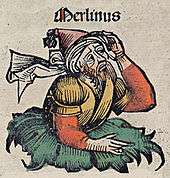
The name "Merlin" is derived from the Welsh Myrddin, the name of the bard who was one of the chief sources for the later legendary figure. Geoffrey of Monmouth Latinised the name to Merlinus in his works. Medievalist Gaston Paris suggests that Geoffrey chose the form Merlinus rather than the regular Merdinus to avoid a resemblance to the Anglo-Norman word merde (from Latin merda) for feces.[6] Other suggestions are that 'Merlin' is an adjective, from the French merle meaning 'blackbird',[7]:79 or that the 'many names' deriving from Myrddin stem from the Welsh: myrdd: myriad.[8][9]
Clas Myrddin or Merlin's Enclosure is an early name for Great Britain stated in the Third Series of Welsh Triads.[10] Celticist A. O. H. Jarman suggests that the Welsh name Myrddin (Welsh pronunciation: [ˈmərðin]) was derived from the toponym Caerfyrddin, the Welsh name for the town known in English as Carmarthen.[11] This contrasts with the popular folk etymology that the town was named after the bard. The name Carmarthen is derived from the town's previous Roman name Moridunum,[6][11] in turn derived from Celtic Brittonic moridunon, 'sea fortress'.[12]
Geoffrey and his sources
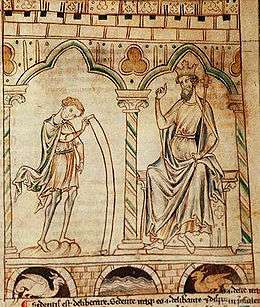
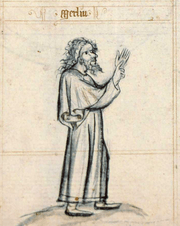
Geoffrey's composite Merlin is based primarily on the madman, poet and seer Myrddin Wyllt ("Myrddin the Wild", sometimes called Merlinus Caledonensis in later sources influenced by Geoffrey), as well as on Emrys (Old Welsh: Embreis), a character based in part on the 5th-century historical war leader Ambrosius Aurelianus who was mentioned in one of Geoffrey's primary sources, the early 9th-century Historia Brittonum.[13] In British poetry, Myrddin was a bard driven mad after witnessing the horrors of war, who fled civilization to become a wild man of the wood in the 6th century.[8] This madman, also known as Lailoken, who has parallels with the Irish Suibhne (Sweeney),[7]:58 roams the Caledonian Forest, until cured of his madness by Kentigern (Saint Mungo). Geoffrey had Myrddin in mind when he wrote his earliest surviving work, the Prophetiae Merlini (Prophecies of Merlin), which he claimed were the actual words of the legendary poet and madman.
Geoffrey's Prophetiae do not reveal much about Merlin's background. He included the prophet in his next work, Historia Regum Britanniae, supplementing the characterisation by attributing to him stories about Aurelius Ambrosius, taken from Nennius' Historia Brittonum. According to Nennius, Ambrosius was discovered when the British king Vortigern was trying to erect a tower at Dinas Emrys. The tower always collapsed before completion, and his wise men told him that the only solution was to sprinkle the foundation with the blood of a child born without a father. Ambrosius was rumoured to be such a child but, when brought before the king, he revealed the real reason for the tower's collapse: below the foundation was a lake containing two dragons who fought a battle representing the struggle between the invading Saxons and the native Celtic Britons. Geoffrey retells this story in his Historia Regum Britanniæ with some embellishments, and gives the fatherless child the name of the prophetic bard Merlin. He goes on to add new episodes that tie Merlin with King Arthur and his predecessors. Geoffrey keeps this new figure separate from Aurelius Ambrosius and, with regard to his changing of the original Nennian character, he states that Ambrosius was also called 'Merlin'—that is, Ambrosius Merlinus.

Geoffrey's account of Merlin Ambrosius' early life is based on the tale of Ambrosius in the Historia Brittonum. He adds his own embellishments to the tale, which he sets in Carmarthen, Wales (Welsh: Caerfyrddin). While Nennius' Ambrosius eventually reveals himself to be the son of a Roman consul, Geoffrey's Merlin is begotten on a king's daughter by an incubus demon. The name of Merlin's mother is not usually stated, but is given as Adhan in the oldest version of the Prose Brut.[14] The story of Vortigern's tower is essentially the same; the underground dragons, one white and one red, represent the Saxons and the Britons, and their final battle is a portent of things to come. At this point Geoffrey inserts a long section of Merlin's prophecies, taken from his earlier Prophetiae Merlini. He tells only two further tales of the character. In the first, Merlin creates Stonehenge as a burial place for Aurelius Ambrosius, bringing the stones from Ireland (the stones actually came from the Preseli Hills in south-west Wales).[15] In the second, Merlin's magic enables the new British king Uther Pendragon to enter into Tintagel Castle in disguise and father his son Arthur with his enemy's wife, Igerna (Igraine). These episodes appear in many later adaptations of Geoffrey's account. As Lewis Thorpe notes, Merlin disappears from the narrative after this; he does not tutor and advise Arthur as in later versions.[4]
Geoffrey dealt with Merlin again in his third work, Vita Merlini. He based it on stories of the original 6th-century Myrddin, set long after his time frame for the life of Merlin Ambrosius. Geoffrey tried to assert that the characters are the same with references to King Arthur and his death, as told in the Historia Regum Britanniae. Here, Merlin survives Arthur, marries a woman named Guendoloena (inspired by the male Gwenddoleu ap Ceidio),[4]:44 and eventually spends his time observing stars from his esplumoir with seventy windows, in the remote woods in the land of Rhydderch. There, he is often visited by his sister Ganieda (based on Myrddin's sister Gwenddydd) who has become queen of the Cumbrians and is also endowed with prophetic powers.
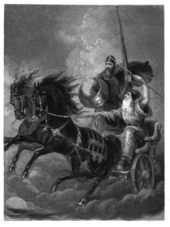
Nikolai Tolstoy hypothesizes that Merlin is based on a historical personage, probably a 6th-century druid living in southern Scotland. His argument is based on the fact that early references to Merlin describe him as possessing characteristics which modern scholarship (but not that of the time the sources were written) would recognize as druidical—the inference being that those characteristics were not invented by the early chroniclers, but belonged to a real person.[17] If so, the hypothetical Merlin would have lived about a century after the hypothetical historical Arthur. A late version of the Annales Cambriae (dubbed the "B-text", written at the end of the 13th century) and influenced by Geoffrey,[18] records for the year 573, that after "the battle of Arfderydd, between the sons of Eliffer and Gwenddolau son of Ceidio; in which battle Gwenddolau fell; Merlin went mad." The earliest version of the Annales Cambriae entry (in the "A-text", written c. 1100), as well as a later copy (the "C-text", written towards the end of the 13th century) do not mention Merlin.[19] Myrddin/Merlin also shares similarities with the shamanic bard figure of Taliesin, alongside whom he appears in the Welsh Triads and in Vita Merlini.
Later versions of the legend
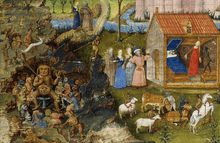
Several decades later, Robert de Boron retold and expanded on this material in his influential Old French poem Merlin. Only a few lines of the poem have survived, but a prose version became popular and was later incorporated into Arthurian chivalric romance literature. In Robert's account, as in Geoffrey's Historia, Merlin is created as a demon spawn, here to become the Antichrist and reverse the effect of the Harrowing of Hell.[note 2] However, this plot is thwarted when a priest named Blaise immediately baptizes the boy at birth, thus freeing him from the power of Satan and his intended destiny.[21] The demonic legacy invests Merlin with a preternatural knowledge of the past and present, which is supplemented by God, who gives the boy a prophetic knowledge of the future. Robert lays great emphasis on Merlin's power to shapeshift, on his joking personality, and on his connection to the Holy Grail, the quest for which he foretells. Inspired by Wace's Roman de Brut, an Anglo-Norman adaptation of Geoffrey's Historia, Merlin was originally a part of a cycle of Robert's poems telling the story of the Grail over the centuries. The narrative of Merlin is largely based on Geoffrey's familiar tale of Vortigern's Tower, Uther's war against the Saxons, and Arthur's conception. What follows is a new episode of the young Arthur's drawing of the sword from the stone,[22] an event orchestrated by Merlin. He also earlier instructs Uther to establish the original order of the Round Table, after creating the table itself. The prose version of Robert's poem was then continued in the 13th-century Merlin Continuation or the Suite de Merlin, describing King Arthur's early wars and Merlin's role in them as he predicts and influences the course of battles.[23] Here, Merlin's shapeshifting powers are also featured prominently.[note 3]
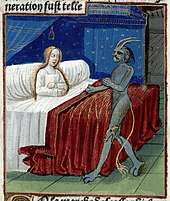
The extended prose rendering became the foundation for the vast Lancelot-Grail cyclical series of Old French prose works also known as the Vulgate Cycle. Eventually, it was directly incorporated into the Vulgate Cycle as the Estoire de Merlin, also known as the Vulgate Merlin or the Prose Merlin. A further reworking and continuation of the Prose Merlin was included within the subsequent Post-Vulgate Cycle as the Post-Vulgate Suite du Merlin or the Huth Merlin. All these variants have been adapted and translated into several other languages, and further modified. Notably, the Post-Vulgate Suite (along with an earlier version of the Prose Merlin) was the main source for the opening part of Thomas Malory's English-language compilation work Le Morte d'Arthur that formed a now-iconic version of the legend. Compared to his French sources, Malory limited the extent of the negative association of Merlin and his powers, relatively rarely being condemned as demonic by other characters such as King Lot.[25] Conversely, Merlin even appeared to be inherently evil in the early, pre-cycle version of the Prose Lancelot in which he was born from not a supernatural rape of a virgin but a consensual union between a princess and a demon,[26] and was never baptized.[27]
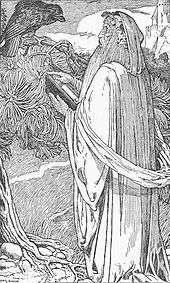
Later medieval works also deal with the Merlin legend, including through unusual stories such as Le Roman de Silence.[28] As the Arthurian myths were retold, Merlin's prophetic aspects were sometimes de-emphasised in favour of portraying him as a wizard and an advisor to the young Arthur, sometimes in struggle between good and evil sides of his character, and living in deep forests connected with nature. He may appear as a "wild man" figure, evoking that of his prototype, Myrddin Wyllt.[29][note 4] In the Perceval en prose (also known as the Didot Perceval and too attributed to Robert), where Merlin is the initiator of the Grail Quest, he eventually retires by turning himself into a bird. In the Vulgate Cycle's version of Merlin, his acts include arranging consummation of Arthur's desire for "the most beautiful maiden ever born," Lady Lisanor of Cardigan, resulting in the birth of Arthur's illegitimate son Lohot from before the marriage to Guinevere.[30][31] But fate cannot always be changed: the Post-Vulgate Cycle has Merlin warn Arthur of how the birth of his other son will bring great misfortune and ruin to his kingdom, which then becomes a self-fulfilling prophecy. Eventually, long after Merlin is gone, his advice to dispose of the baby Mordred through an event evoking the Biblical Massacre of the Innocents leads leads to the deaths of many, including Arthur.
The earliest English verse romance concerning Merlin is Of Arthour and of Merlin, which drew from the chronicles and the Vulgate Cycle. In English-language medieval texts that conflate Britain with the Kingdom of England, the Anglo-Saxon enemies against whom Merlin aids first Uther and then Arthur tend to be replaced by the Saracens[32] or simply just invading pagans. Meanwhile, some of the many Welsh works predicting the Celtic revenge and victory over the Saxons have been reinterpreted as Merlin's (Myrddin's) prophecies, later used by propaganda of the Welsh-descent king Henry VIII of England. The Prophéties de Merlin (c. 1276) contains long prophecies of Merlin (mostly concerned with 11th to 13th-century Italian history and contemporary politics), some by his ghost after his death, interspersed with episodes relating Merlin's deeds and with assorted Arthurian adventures in which Merlin does not appear at all. Even more political Italian text was Joachim of Fiore's Expositio Sybillae et Merlini, directed against Frederick II, Holy Roman Emperor whom the author regarded as the Antichrist. The earliest Merlin text in German was Caesarius of Heisterbach's Dialogus Miraculorum (1220), originally in Latin. Ulrich Füetrer's 15th-century Buch der Abenteuer presents Merlin as Uter's father, effectively making his grandson Arthur a part-devil too.
Merlin's end
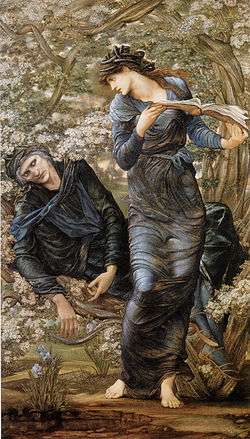
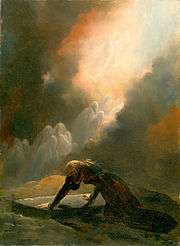
In chivalric romance tradition, Merlin has a major weakness that eventually leads him to his doom: young beautiful women of femme fatale archetype. His apprentice is often Arthur's half-sister Morgan le Fay (in the Prophéties de Merlin along with Sebile and two other witch queens), who is sometimes depicted as Merlin's lover[33] and sometimes as just an unrequited love interest.[note 5] While Merlin does share his magic with them, his prophetic powers cannot be passed on. Contrary to the many modern works in which they are archenemies, Merlin and Morgan are never opposed to each other in any medieval tradition, other than Morgan forcibly rejecting him in some texts; in fact, his love for Morgan is so great that he even lies to the king in order to save her in the Huth Merlin, which is the only instance of him ever intentionally misleading Arthur.[35][note 6] Instead, Merlin's eventual undoing comes from his lusting after another of his female students, named Viviane (among other names and spellings, including Malory's popular Nimue); also called a fairy (French fee) like Morgan, Viviane is first found in the Lancelot-Grail cycle, having been inserted into the legend by either de Boron or his continuator. Merlin's fate of either demise or eternal imprisonment, along with his destroyer or captor's motivation (from her fear of Merlin and protecting her own virginity, to her jealously for his relationship with Morgan), is recounted differently in variants of this motif but is usually placed within the enchanted forest of Brocéliande.[note 7] The form of his prison or grave can be variably a crystal cave, a hole under a large rock (as in Le Morte d'Arthur), a magic tower, or a tree.[24] In some texts, including in Le Morte d'Arthur, she then replaces Merlin in the role of Arthur's court mage and adviser as a Lady of the Lake (the chief Lady in case of Malory's Nimue) following the 'last enchantement'.[36] Malory's telling of this episode would later become a major inspiration for Romantic authors and artists of the 19th century.[note 8]
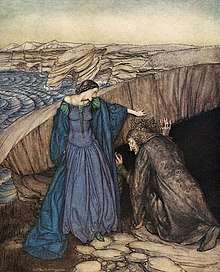
"How by her subtle working she made Merlin to go under the stone to let wit of the marvels there and she wrought so there for him that he came never out for all the craft he could do."
There are many different versions of their story. Common themes in most of them include Merlin usually having the prior prophetic knowledge of her plot against him (one exception is the Spanish Post-Vulgate Baladro where his ability is dampened by lust[38]), but lacking either ability or will to counteract it in any way, along with her usually using one of his own spells against him. Niniane, as the Lady is known in the Livre d'Artus continuation of Merlin, breaks his heart prior to his later second relationship with Morgan, but here the text actually does not tell how exactly Merlin did vanish, other than relating his farewell to Blaise. In the Post-Vulgate Suite, the young King Bagdemagus manages to find the rock under which Merlin is entombed alive by Niviene; he communicates with Merlin, but cannot lift it. What follows next is supposedly narrated in the mysterious text Conte del Brait (Tale of the Cry).[note 9] In the Prophéties de Merlin version, his tomb is unsuccessfully searched for by various parties, including by Morgan and her enchantresses, but cannot be accessed due to the deadly magic traps around it,[41] while the Lady of the Lake comes to taunt Merlin by asking did he rot there yet.[39] In the Vulgate Lancelot, which predated the later Vulgate Merlin, she (aged just 12 at the time) instead makes Merlin sleep forever in a pit in the forest of Darnantes, "and that is where he remained, for never again did anyone see or hear of him or have news to tell of him."[42] In a version with a happier ending, contained within the Premiers Faits section of the Livre du Graal and evoking the final scenes from Vita Merlini, Niniane peacefully confines him in Brocéliande with walls of air, visible only as a mist to others but as a beautiful yet unbreakable crystal tower to him,[note 10] where they then spend almost every night together.[43]
The legendary Brocéliande is often identified as the real-life Paimpont forest in Brittany.[5] Other purported sites of Merlin's burial include a cave deep inside Merlin's Hill (Welsh: Bryn Myrddin), outside Carmarthen. Carmarthen is also associated with Merlin more generally, including through the 13th-century manuscript known as the Black Book of Carmarthen and the local lore of Merlin's Oak.
In North Welsh tradition, Merlin retires to Bardsey Island (Welsh: Ynys Enlli), where he lives in a house of glass (Welsh: Tŷ Gwydr) with the Thirteen Treasures of the Island of Britain (Welsh: Tri Thlws ar Ddeg Ynys Prydain).[44]:200 One site of his tomb is said to be Marlborough Mound in Wiltshire,[45] known in medieval times as Merlebergia.[note 11] Another site associated with Merlin's burial, in his 'Merlin Silvestris' aspect, is the confluence of the Pausalyl Burn and River Tweed in Drumelzier, Scotland. The 15th-century Scotichronicon tells that Merlin himself underwent a triple-death, at the hands of some shepherds of the under-king Meldred: stoned and beaten by the shepherds, he falls over a cliff and is impaled on a stake, his head falls forward into the water, and he drowns.[note 12] The fulfilment of another prophecy, ascribed to Thomas the Rhymer, came about when a spate of the Tweed and Pausayl occurred during the reign of the Scottish James VI and I on the English throne: "When Tweed and Pausayl meet at Merlin's grave, / Scotland and England one king shall have."[8]:62
Modern fiction
The subject of Merlin has continued to be popular through the Renaissance and afterwards, especially since the renewed interest in the legend of Arthur in modern times. As noted by Arthurian scholar Alan Lupack, "numerous novels, poems and plays center around Merlin. In American literature and popular culture, Merlin is perhaps the most frequently portrayed Arthurian character."[46] Diverting from his traditional role in the legends, sometimes Merlin is a villain, such as in Mark Twain's satire of the legend, A Connecticut Yankee in King Arthur's Court (1889).[46]
See also
- 2598 Merlin, an asteroid named in honour of the legendary figure
- Merlin's Cave, a location under Tintagel Castle
Notes
- According to Alan Lupack, "Merlin plays many roles in Arthurian literature, including bard, prophet, magician, advisor, and warrior. Though usually a figure who supports Arthur and his vision of Camelot, Merlin is, because of the stories in which he is said to be the son of a devil, sometimes presented as a villain."[1]
- One version of the Prose Tristan makes him by the same token a "half-brother" of the monster known as the Questing Beast.[20]
- Merlin appears as a woodcutter with an axe about his neck, big shoes, a torn coat, bristly hair, and a large beard. He is later found in the forest of Northumberland by a follower of Uther disguised as an ugly man and tending a great herd of beasts. He then appears first as a handsome man and then as a beautiful boy. Years later, he approaches Arthur disguised as a peasant wearing leather boots, a wool coat, a hood, and a belt of knotted sheepskin. He is described as tall, black and bristly, and as seeming cruel and fierce. Finally, he appears as an old man with a long beard, short and hunchbacked, in an old torn woolen coat, who carries a club and drives a multitude of beasts before him.[24]
- In the Livre d'Artus, for instance, Merlin enters Rome in the form of a huge stag with a white fore-foot. He bursts into the presence of Julius Caesar (here Arthur's contemporary) and tells the emperor that only the wild man of the woods can interpret the dream that has been troubling him. Later, he returns in the form of a black, shaggy man, barefoot, with a torn coat. In another episode, he decides to do something that will be spoken of forever. Going into the forest of Brocéliande, he transforms himself into a herdsman carrying a club and wearing a wolf-skin and leggings. He is large, bent, black, lean, hairy and old, and his ears hang down to his waist. His head is as big as a buffalo's, his hair is down to his waist, he has a hump on his back, his feet and hands are backwards, he is hideous, and is over 18 feet tall. By his arts, he calls a herd of deer to come and graze around him.[24]
- As summarized by Anne Berthelot, depending on the version of the narrative, "it may be that a lustful Merlin seduces an (almost) innocent Morgue [Morgan], thus pushing her to her déchéance (downfall). Or Morgue may appear as an ambitious and unscrupulous bitch ready to seduce an old tottering Merlin in order to gain the wisdom he alone can dispense."[34]
- Merlin also otherwise protects Morgan in several other texts, including warning her of Arthur's wrath in Malory's telling of the plot of Accolon.
- In the Post-Vulgate Suite du Merlin, for example, Viviane (Niviene) is introduced as a young teenage princess. She is about to depart from Arthur's court following her initial episode but, with some encouragement from Merlin, Arthur asks her to stay in his castle with the queen. During her stay, Merlin falls in love with her and desires her. Viviane, frightened that Merlin might take advantage of her with his spells, swears that she will never love him unless he swears to teach her all of his magic. Merlin consents, unaware that throughout the course of her lessons, Viviane will use Merlin's own powers against him, forcing him to do her bidding. When Viviane finally goes back to her country, Merlin escorts her. However, along the way, Merlin receives a vision that Arthur is in need of assistance. Viviane and Merlin rush back to Arthur's castle, but have to stop for the night in a stone chamber, once inhabited by two lovers. Merlin relates that when the lovers died, they were placed in a magic tomb within a room in the chamber. That night, while Merlin is asleep, Viviane, still disgusted with Merlin's desire for her, as well as his demonic heritage, casts a spell over him and places him in the magic tomb so that he can never escape, thus causing his death.
- In Tennyson's Merlin and the Gleam, for instance, Merlin tells a 'young mariner' as he is about to actually die: "I am Merlin, / And I am dying, / I am Merlin / Who follow The Gleam."[37]
- The Conte referred to in the story is an unknown, supposedly separate text that might have been just fictitious.[39] However, in the Spanish Post-Vulgate manuscript known as the Baladro del sabio Merlin (The Shriek of the Sage Merlin), Merlin tells Bagdemagus that only Tristan could opened the cave's iron door, but Tristan is by then still just a baby. He than gives the story's eponymous great cry in a demonic voice, calling for his father to come and take him, and dies amidst a terrific supernatural event.[40]
- However, Merlin's disembodied voice can escape his air prison, as he later speaks to Gawain when the latter happens to come by.[39]
- In 1215, the Abbot of Cirencester wrote: "Merlin's tumulus gave you your name, Merlebergia."[44]:93
- Merlin is credited with predicting this: "Today I will perish, overwhelmed by stones and cudgels. / Today by body will be pierced through by a sharp stake / of wood, and so my life will expire. / Today I shall end my present life engulfed in the waves."[8]:67
References
Citations
- "Frequently Asked Questions about the Arthurian Legends | Robbins Library Digital Projects". d.lib.rochester.edu. Retrieved 2019-06-27.
- Lloyd-Morgan, Ceridwen. "Narratives and Non-Narrtives: Aspects of Welsh Arthurian Tradition." Arthurian Literature. 21. (2004): 115–136.
- Katharine Mary Briggs (1976). An Encyclopedia of Fairies, Hobgoblins, Brownies, Boogies, and Other Supernatural Creatures, p.440. New York: Pantheon Books. ISBN 0-394-73467-X
- Geoffrey of Monmouth (1977). Lewis Thorpe (ed.). The History of the Kings of Britain. Penguin Classics. Penguin Books. ISBN 978-0-14-044170-3.
- "The enchanted wood". Sydney Morning Herald. March 26, 2005. Retrieved 2018-07-07.
- "Merlin". Oxford English Dictionary. 2008. Archived from the original on June 29, 2011. Retrieved June 7, 2010.
- Markale, J (1995). Belle N. Burke (trans) Merlin: Priest of Nature. Inner Traditions. ISBN 978-0-89281-517-3. (Originally Merlin L'Enchanteur, 1981)
- Dames, Michael. Merlin and Wales: A Magician's Landscape, 2004. Thames & Hudson Ltd. ISBN 0-500-28496-2
- Collins, Little Gem (2009). Welsh Dictionary. Harper Collins. ISBN 978-0-00-728959-2.
- Rhys, John: Hibbert Lectures, p. 168.
- Koch, Celtic Culture, p. 321.
- Delamarre, Xavier (201), Noms de lieux celtiques de l'Europe ancienne, Errance, Paris (in French).
- Ashe, Geoffrey. The Discovery of Arthur, Owl Books, 1987.
- Bibliographical Bulletin of the Arthurian Society Vol. LIX (2007). P. 108, item 302.
- "Building Stonehenge". English Heritage.
- Marshall, Emily (1848). The Rose, or Affection's Gift. Boston Public Library. New York, N.Y. : D. Appleton & Co.
- Tolstoy, Nikolai (1985). The Quest for Merlin. Hamish Hamilton. ISBN 0-241-11356-3.
- Curley, Michael, Geoffrey of Monmouth, Cengage Gale, 1994, p. 115.
- Gough-Cooper, Henry (2012). "Annales Cambriae, from Saint Patrick to AD 682: Texts A, B & C in Parallel Archived 2013-05-15 at the Wayback Machine". The Heroic Age, Issue 15 (October 2012).
- Berthelot, Anne (2000). "Merlin and the Ladies of the Lake". Arthuriana. 10 (1): 55–81 – via JSTOR.
- "The Birth of Merlin". University of Rochester Robbins Library Digital Projects. Retrieved 2019-06-19.
- "Arthur and the Sword in the Stone". University of Rochester Robbins Library Digital Projects. Retrieved 2019-06-19.
- "Prose Merlin". University of Rochester Robbins Library Digital Projects. Retrieved 2019-06-19.
- Loomis, Roger Sherman (1927). Celtic Myth and Arthurian Romance. Columbia University Press.
- https://www.ncbi.nlm.nih.gov/books/NBK535700/
- Dover, Carol (2003). A Companion to the Lancelot-Grail Cycle. DS Brewer. ISBN 978-0-85991-783-4.
- Cartlidge, Neil (2012). Heroes and Anti-heroes in Medieval Romance. DS Brewer. ISBN 978-1-84384-304-7.
- Sauer, Michelle M. (2015-09-24). Gender in Medieval Culture. Bloomsbury Publishing. ISBN 978-1-4411-8694-2.
- Koch, Celtic Culture, p. 1325.
- Guerin, M. Victoria (1995). The Fall of Kings and Princes: Structure and Destruction in Arthurian Tragedy. Stanford University Press. ISBN 978-0-8047-2290-2.
- Lacy, Norris J. (2010). Lancelot-Grail: The Story of Merlin. Boydell & Brewer Ltd. ISBN 978-1-84384-234-7.
- Calkin, Siobhain Bly (2013). Saracens and the Making of English Identity: The Auchinleck Manuscript. Routledge. ISBN 978-1-135-47171-2.
- "Arthur and Gawain - Robbins Library Digital Projects". rochester.edu. Archived from the original on 19 November 2017. Retrieved 1 May 2018.
- Berthelot, Anne (2000). "Merlin and the Ladies of the Lake". Arthuriana. 10 (1): 55–81. ISSN 1078-6279. JSTOR 27869521.
- Goodrich, Merlin: A Casebook, p. 149–150.
- Mangle, Josh (2018-05-01). "Echoes of Legend: Magic as the Bridge Between a Pagan Past and a Christian Future in Sir Thomas Malory's Le Morte Darthur". Graduate Theses.
- Tennyson, Alfred, Lord. "Merlin and the Gleam". Clas Merdin. Retrieved 1 March 2020.
- https://www.jstor.org/stable/27869522
- Griffin, Miranda (2015). Transforming Tales: Rewriting Metamorphosis in Medieval French Literature. Oxford University Press. ISBN 978-0-19-968698-8.
- Bogdanow, Fanni (1966). The Romance of the Grail: A Study of the Structure and Genesis of a Thirteenth-century Arthurian Prose Romance. Manchester University Press. p. 54.
- Larrington, Carolyne. "The Enchantress, the Knight and the Cleric: Authorial Surrogates in Arthurian Romance'". Cite journal requires
|journal=(help) - Lacy, Norris J. (2010). Lancelot-Grail: Lancelot, pt. I. Boydell & Brewer Ltd. ISBN 978-1-84384-226-2.
- Goodrich, Merlin: A Casebook, p. 168.
- Ashe, Geoffrey (2008). Merlin, the Prophet and his History. Sutton. ISBN 978-0-7509-4149-5.
- "Merlin's Mount, Marlborough, Wiltshire". The Northern Antiquarian. Retrieved 1 March 2020.
- "Merlin | Robbins Library Digital Projects". d.lib.rochester.edu. Retrieved 2019-07-04.
Bibliography
- Goodrich, Peter H. (2004). Merlin: A Casebook. Routledge. ISBN 978-1-135-58340-8.
- Koch, John T. (2006). Celtic Culture: A Historical Encyclopedia. ABC-CLIO. ISBN 978-1-85109-440-0.
External links
| Wikiquote has quotations related to: Merlin |
| Wikimedia Commons has media related to Merlin (legendary figure). |
| Wikisource has original text related to this article: |
- Merlin: Texts, Images, Basic Information, Camelot Project at the University of Rochester. Numerous texts and art concerning Merlin
- Timeless Myths: The Many Faces of Merlin
- BBC audio file of the "Merlin" episode of In Our Time
- Prose Merlin, Introduction and Text (the University of Rochester TEAMS Middle English text series) edited by John Conlea, 1998. A selection of many passages of the prose Middle English translation of the Vulgate Merlin with connecting summary. The sections from "The Birth of Merlin to "Arthur and the Sword in the Stone" cover Robert de Boron's Merlin